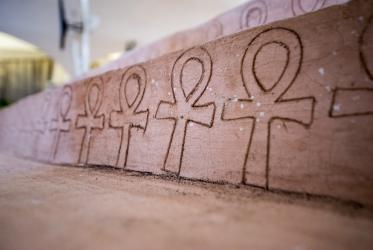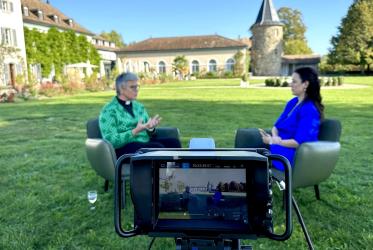This publication has been developed from the WCC Commission on Faith and Order through a very unique procedure. Are you able to give us a short introduction to its content and describe the process to our readers?
Rev. Dr Durber: This booklet tries to summarise in just 19 pages the fruits of a conversation with the churches that has taken place over decades! “The Church: Towards a Common Vision” was published in 2013 and was sent to the churches with a request for responses. We received 78, from churches, ecumenical bodies and some individuals. Some were a paragraph or two and others many pages. A group of Faith and Order commissioners read all of them carefully and reflected on them. There are other, much longer, publications that came from that process, but this booklet is a short, accessible summary of what the responses revealed. The churches now agree on much more than they disagree, about the apostolic faith, about the sacraments and about the vital importance of mission. But they have questions about what unity might look like, about the limits of diversity and about how to resolve today’s most difficult divisions, particularly on moral issues.
In what ways could the churches and all readers benefit from this report?
Bishop Maxim: This document places Faith and Order at the center of ecumenical work, for it is mainly through a theological position that can justify the WCC’s vision. This document bears witness to the times we live in and to the efforts of members of churches to come closer to the self-understanding of the early church. It also reveals how the churches have begun to learn from each other. Faith and Order employed the creative theologians of all traditions (as it was in the past) and, keeping the focus on the visible unity of the church, it now includes all its fundamental aspects, such as the deep faith in the triune God, threefold ministry, sacraments, the church local and universal, ecumenical councils, reception, etc. This document clarifies that it is not enough for the Christians to unite in the struggle for social issues; they must not abandon their efforts to join in church structure, ministry, sacraments, confession of faith, etc. The concept of koinonia turned into a standard tool in the document is a notion that links up doctrine with ethics. This document responds to the new challenges of our time, to which the Christian churches must react if they are not prepared to become marginalized in history. This project satisfies the Orthodox concern to seriously consider doctrine as formulated by the fathers of the church and the ecumenical councils. We cannot be genuinely united unless we can confess the same faith in a creed accepted by all.
Please share with us the landmarks of the commission’s work on ecclesiology during the past years. Which publications led us to the report “What Are the Churches Saying About the Church?”
Rev. Dr Durber: This work on ecclesiology (how we understand what it means to be the church) began, in a sense, with “Baptism, Eucharist and Ministry,” published as long ago as 1982. The responses to that landmark text revealed that it was questions around different understandings of ministry, authority and order that were the most difficult to resolve – there needed to be further work. This led to a text called “The Nature and Purpose of the Church” in 1999 and then to a second revision called “The Nature and Mission of the Church” in 2005. After more discussion, and a call to do theology “from below,” a new text was drafted – “The Church: Towards a Common Vision.” These texts are easy to find and read, but the process also involved many, many discussions and consultations on the way, countless people involved, many drafts and re-drafts. The work is ongoing and requires patient work and dedication.
Why is the WCC Faith and Order work on ecclesiology relevant nowadays? How would you describe its importance to people from all fields of work and academic research?
Bishop Maxim: It is relevant because it demonstrates a “relational ecumenism” of the concrete encounter between those who share a thirst for life that can conquer death. Many of the responses reflect a sincere desire to do theology connected to the concerns of daily life, looking for real answers to the “dead ends” of the civilization in which we live today. “The Church: Towards a Common Vision” is an important landmark mainly because its ecclesiological perspective included hermeneutics, through which it became evident that the churches now agree on so much more than they disagree. Knowledge—understood today as information—is not interesting anymore. The work of the historian of ecumenism is not conceivable without hermeneutics. In the WCC Faith and Order work, many will rediscover aspects that have been forgotten or neglected about being the church. By including themes such as legitimate diversity, a theology of humankind, the church and sin, etc., the document strengthens the issue of church unity but also a theology beyond “horizontalism.” Looking from the Orthodox tradition, the eucharistic and sacramental dimension of the church has important cosmological significance, which produces an ethos required so badly today to face the ecological problem. This is where we realize that ecclesiology cannot remain a narrow doctrinal matter.
What is your vision for the Faith and Order future work on ecclesiology, after the WCC 11th Assembly?
Rev. Dr Durber: This kind of work doesn’t move in straight lines, inexorably making “progress.” It will always be part of the church’s life to keep reflecting on what it means to be the church, and it’s vital that divided churches do this together; so that we learn from each other’s gifts and find ways to overcome those divisions. In the days when BEM was published it was exciting and new and there were real “breakthrough" moments. Now the challenge, in rather different times, is to keep on going, until we are led to new moments of real change, when Christ’s hope for unity becomes our hope too. Part of the vision is to keep going. It may be unpopular, but it is vital.
Another vision is that more people, from those churches and communities not yet eager partners in the conversation, might join in. That will change the conversation, but it will need to change so that this kind of theological work becomes more open to the wealth of theological method and style alive in the church today.
Bishop Maxim: Until recently, ecumenism had a goal to give the various traditions and confessions a chance to develop mutual knowledge. “The Church: Towards a Common Vision” and responses give younger theologians an idea of where we are in Faith and Order now and where we hope to move in the future, especially in view of the coming jubilee of Nicaea (325-2025). Soon, I expect another kind of ecumenism, which will go beyond the problems of the third world, feminism, individual rights, etc. As Christians, we are responsible for the dead ends of our civilization. A deeper discussion on all aspects of ecclesiology (baptismal, eucharistic, conciliar, etc.) will be able to open new paths in discovering the true nature and task of the church, which is to free us from the constraints of the created world. I hope that the new generation of theologians will get inspired by this document and enter an immediate relationship with God, who called us from non-being into being. My expectation is that the coming generation of theologians will be more creative than we have been.
Other relevant publications on this process are:
Churches Respond To The Church: Towards A Common Vision Volume I. Faith and Order Paper No. 231
Churches Respond To the Church: Towards a Common Vision Volume II. Faith and Order Paper No. 232
Common Threads: Key Themes from Responses to The Church: Towards a Common Vision. Faith and Order Paper No 233






